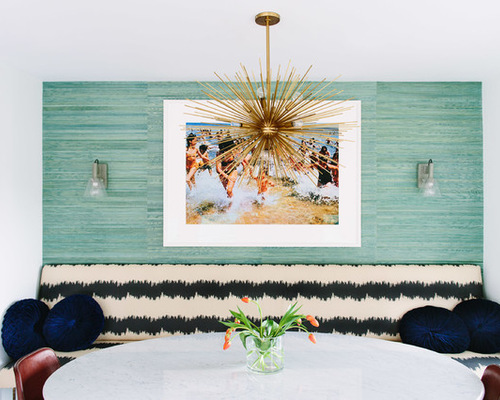What Is Grasscloth?
Grasscloth is an umbrella term commonly used to describe wallcovering made from hand-woven strands of natural fibers on an unpasted rice paper backing. The fibers include hemp, jute, seagrass, arrowroot grass, bamboo and raffia. Some manufacturers identify the specific fiber type, but others don’t and instead use grasscloth as a catchall phrase. Grasscloth’s characteristic 36-inch width is atypical of wall coverings, which usually come in standard 21- and 27-inch widths.How Grasscloth Differs From Other Wallpapers
Like snowflakes, no two rolls of grasscloth wallpaper are alike. Fibers on one roll may vary in size, color or value from the next roll. The horizontal filaments will never line up side to side from one roll to another. The striated pattern will look offset up on the wall, resulting in a paneled effect. Depending on the fiber type, it may take dye unevenly, creating beautiful variegation, as in this example. So you should expect grasscloth rolls — unlike other types of wall covering made in controlled factory conditions, such as printed papers — to be (delightfully) inconsistent. “Hanging natural grasses requires that you bend your brain 180 degrees and ignore, or even celebrate, what would normally be gross variations in a machine-made product,” says wallpaper installer Jim Parodi of Jim Parodi Wallpapering.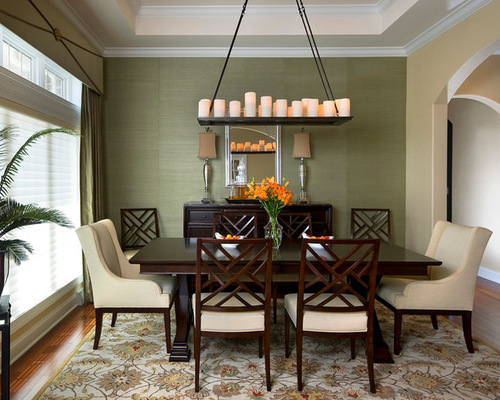 Traditional Dining Room, original photo on Houzz
In fact, the variation can be so unpredictable that many people initially cite a manufacturing defect. Parodi says he once installed a light green grasscloth project that had one roll with a natural, but fairly bright, red stripe down its center. Color variations like these are not considered defects and are not cause for return. In fact, most manufacturers disclose a disclaimer about it being a natural, hand-made product. Expect a roll or two to visually stick out in some way. For example, the far right side of this dining room installation appears darker than the adjacent pieces.
Also make sure that your significant other is on the same page about the random appearance. If irregularity, or the possibility of it, sends your heart aflutter, then grasscloth will not be your best wallpaper pick.
Traditional Dining Room, original photo on Houzz
In fact, the variation can be so unpredictable that many people initially cite a manufacturing defect. Parodi says he once installed a light green grasscloth project that had one roll with a natural, but fairly bright, red stripe down its center. Color variations like these are not considered defects and are not cause for return. In fact, most manufacturers disclose a disclaimer about it being a natural, hand-made product. Expect a roll or two to visually stick out in some way. For example, the far right side of this dining room installation appears darker than the adjacent pieces.
Also make sure that your significant other is on the same page about the random appearance. If irregularity, or the possibility of it, sends your heart aflutter, then grasscloth will not be your best wallpaper pick.
Location, Location, Location
Despite being the perfect backdrop to most any decor style, grasscloth isn’t the right choice for every room in your house. Living rooms, dining rooms, studies and bedrooms are generally better rooms to indulge one’s grasscloth fantasies. Here’s why: Water woes. Grasscloth’s nemesis is water. Some grasscloth fiber types are more forgiving than others, but in general, it is highly susceptible to water marks after making contact with water or high humidity. In keeping with the natural material theme, many grasscloth wallpapers are also colored with natural dyes, which can actually bleed off onto other materials and furnishings. Because water and grasscloth don’t mix, grasscloth wallpaper can’t be cleaned in the traditional sense (I’ll touch on maintenance later). So installing grasscloth near a sink where it can be easily splashed or around a toilet can be a hygienic disaster.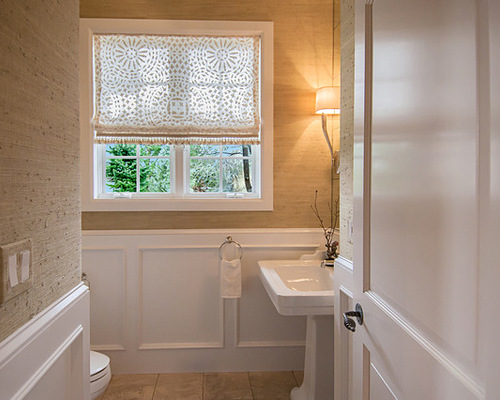 Oliver Designs, original photo on Houzz
Oliver Designs, original photo on Houzz
How to Use Grasscloth in Bathrooms
If you’re bent on using grasscloth wallpaper in a bathroom, take common-sense precautions. First, for bathrooms with bathing facilities, make sure that you have a superb exhaust system. Any lingering steam will settle on the wallpaper surface and eventually cause staining or, at a minimum, a shortened life span. Second, avoid contact with any plumbing fixtures by installing the grasscloth above wainscoting, as in this example. The wall behind this powder room sink is mirrored instead of wallpapered.Scent Sense
Another consideration is indoor odor. Natural materials are porous, and can absorb and hold scent. Parodi says he received a frantic phone call from a client whose grasscloth-papered dining room still smelled like her husband’s cigar-fueled boys’ night in. “Many people do not realize that grasscloth on walls is like having fabric drapes that cannot be sent out and cleaned,” he says. Besides tobacco, strong food smells, like that of fried fish, can also linger on grasscloth wallpaper. Carefully reflect on your family’s lifestyle before going the grasscloth route.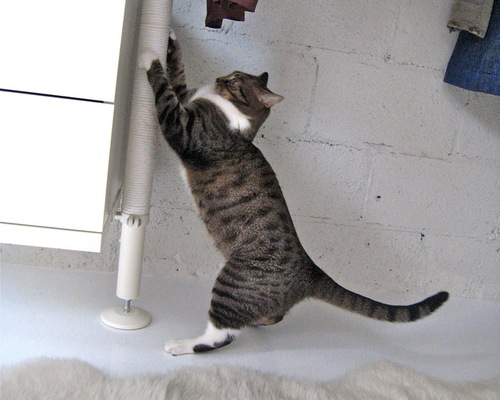 Betty’s Room, LLC, original photo on Houzz
Betty’s Room, LLC, original photo on Houzz
Claws for Concern
Although this kitty has a nifty rope-wrapped pole, many cats find the natural scent and texture of grasscloth wallpaper irresistible for sharpening claws. If you have indoor cats, it may be prudent to install grasscloth wallpaper above a chair rail instead of the entire wall length.No Easy Cure for Bangs and Bumps
Grasscloth wallcovering is somewhat delicate and, unlike standard printed wallpaper, doesn’t take patched repairs well without being noticeable. Be careful about installing grasscloth in hallways, especially narrow ones, where it may be frequently banged by passers-by or furniture moving.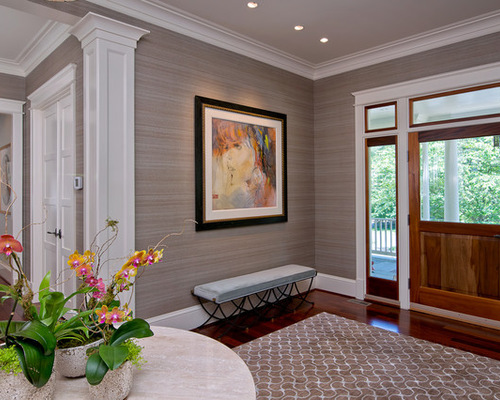 L.S. Design, original photo on Houzz
L.S. Design, original photo on Houzz
Not so Sunny
Like many other natural materials, grasscloth wallpaper, especially those dyed dark colors, can fade in sunlight. Although grasscloth may seem like a perfect wallcovering for your sunroom, its lifetime there will likely be curtailed. Instead, interior rooms or those with adequate window shades (or an architectural overhang, such as the exterior porch in this example) are better alternatives.Get Professional Installation
Parodi says grasscloth is one of the most challenging wallcoverings to install. There are likely a few DIYers out there who have had great success. However, compared with standard wallpaper, its installation is different and requires specialized know-how, tools and impeccable wall prep with particular materials, not to mention an approximately doubled installation time. Not all experienced wallpaper installers are competent with grasscloth installation, so be sure to hire one who is.Here’s a Lowdown on Some of Its Installation Complexities
Complicated Wall Prep
Depending on whether the walls are old or new plaster, new drywall, or drywall painted with oil paint or latex paint, the prep material requirement will vary. This article isn’t a primer on DIY grasscloth installation. However, in most cases, Parodi suggests sealing the wall with a 100 percent acrylic pigmented primer before wallpapering. He says it is the least water-sensitive primer and creates a hard surface on drywall paper. It also blocks out and seals anything on the wall that may bleed through to damage the paper. Furthermore, it provides a “bite” that the wallpaper can grip and facilitates future wallpaper removal, which folks often disregard. For adhesive, Parodi creates a custom mix based on the density of the weave. Thinner, lighter grasscloths, he says, work well with powders made of wheat and potato starch. He sometimes incorporates a clear premixed adhesive, which allows for extra tackiness and work time.Custom-Cut Widths
Unlike other wallpaper installations that maximize the number of full rolls on a wall, and balance out fill-in pieces on the sides, seasoned grasscloth installers attempt, when possible, to install consistent roll widths across a wall. This prevents danglers at the corners. So on a 100-inch-wide wall, instead of installing two full 36-inch rolls and balancing the remaining 28 inches, competent installers cut three 36-inch rolls down to 33?inches so that they fit equally. This not only requires a great deal of skill, but also the right tools. Parodi says he uses professional Japanese-made shears and razor blades to make grasscloth cuts.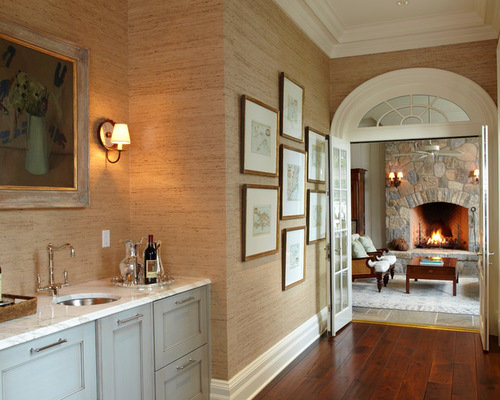 Wright Building Company, original photo on Houzz
Wright Building Company, original photo on Houzz

